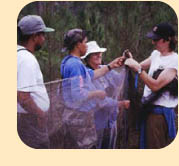Project Description and Current Status: A key element of any successful riparian restoration program is evaluation, monitoring, and adaptive management to ensure restoration goals that include positive benefits to wildlife are met. Monitoring multiple species of birds is a relatively easy and cost effective way to track changes in natural systems. While we have been successful in assessing the importance of riparian habitats and have fundamentally changed the way restoration is implemented for breeding songbirds, similar data for nonbreeding communities are severely lacking.
Because many species of wintering migrants have been shown to segregate by sex and age class, abundance data alone can be a misleading indicator of population size and habitat preference. Furthermore, abundance cannot be equated with survival, so data on site fidelity, including overwinter site persistence and annual return rate, are required to assess habitat quality. Thus, recent studies have focused on habitat-specific demographies and site fidelity of wintering warblers.
 Our protocol is based on previous work on migrant winter ecology and habitat preferences. Unlike protocols which depend on capture-recapture models alone to determine site fidelity and survival, this intensive protocol allows analysis of data from a small number of related sites because of the inclusion of resight data and the ability to then track more individuals in the color-banded population.
Our protocol is based on previous work on migrant winter ecology and habitat preferences. Unlike protocols which depend on capture-recapture models alone to determine site fidelity and survival, this intensive protocol allows analysis of data from a small number of related sites because of the inclusion of resight data and the ability to then track more individuals in the color-banded population.
Wintering Neotropical migrants are now being investigated at plots in 6 watersheds (2 Californian, 4 Mexican). In each watershed we have 2-4 sites of 12-20 ha each in well-conserved riparian habitat or restored riparian habitat. At 2 Mexican watersheds (Baja California and Yucatán Peninsula) we did not locate plots in restored habitats because restoration activities have not yet been undertaken.
Three rounds of point counts and constant-effort mistnetting are taking place in early-winter (November), midwinter (early-January), and late-winter (late-February to early-March). Following banding efforts, each site is being systematically searched for color-banded individuals, and their location and any territorial behavior is recorded on a map of the plot. Resighting continues until observers are confident that no colorbanded birds remain unidentified on or near the site. Resighting of color-marked birds will be used to determine site fidelity and overwinter site persistence or survival over the winter nonbreeding season.
Intensive monitoring will also provide badly needed data on life history traits and demography of species, and provide direct information on habitat conditions necessary for overwinter survival. Together these data are required to assess the winter ecology of Neotropical migratory birds and habitat conditions for land and species management.
University students from Mexico have been recruited to take lead roles in research activities at three of the Mexican field sites, and this work will be included in their theses. Other students or aspiring biologists have been integrated as interns for field work and serve at each site as trainees to master field research and avian monitoring techniques. Each intern is being mentored by a trained biologist.
Recent Results: Preliminary results will be available in 2008. Stay tuned!
Funding: This project has been supported by the U.S. Fish and Wildlife Service through the Neotropical Migratory Bird Conservation Act, the Sonoran Joint Venture, and by PRBO Conservation Science and their partners and donors.
Related Scientific Publications:
Latta, S. C. 2003. Effects of scaley-leg mite infestations on body condition and site fidelity of migratory warblers. Auk 120:730-743.
Latta, S. C., and M. Baltz. 1997. Population limitation in Neotropical migratory birds: Comments on Rappole and McDonald (1994). Auk 114:754-762.
Latta, S. C., and J. Faaborg. 2001. Winter site fidelity of Prairie Warblers in the Dominican Republic. Condor 103:455-468.
Latta, S. C., and J. Faaborg. 2002. Demographic and population responses of Cape May Warblers wintering in multiple habitats. Ecology 83:2502-2515.
Latta, S. C., C. C. Rimmer, and K. P. McFarland. 2003. Winter bird communities in four habitats along an elevational gradient on Hispaniola. Condor 105:179-197.
Wunderle, J. M., Jr., and S. C. Latta. 2000. Winter site fidelity of Nearctic migrant birds in isolated shade coffee plantations of different sizes in the Dominican Republic. Auk 117: 596-614.


